Have you ever picked out a nice skirt to wear to work and then realized that your legs will freeze if you don’t pull on a pair of tights or leggings? You probably have dozens of pairs of leggings and tights and may sometimes find yourself confused over which one you should wear with a certain outfit. When you compare leggings vs tights, what exactly is the difference?
The main difference between leggings and tights is that tights are almost always made out of sheer fabric, while leggings usually feature opaque fabric. Tights usually cover the whole foot, while leggings usually end at the ankle. Both garments contain a large amount of spandex to create a skintight feel.
In this article, you will find out the key characteristics of both leggings and tights. You will learn which garment works best with certain styles of clothing. Finally, you will find a comparison of leggings, tights, and yoga pants.
Quick Navigation
- What Are Leggings?
- What Are Tights?
- Leggings vs Tights: Key Points
- What Is the Difference Between Leggings and Tights?
- Types of Leggings
- Types of Tights
- Leggings vs Tights vs Yoga Pants
- Running Tights vs Leggings
- Pantyhose vs Leggings
- Leggings vs Stockings
- Is It Ok to Wear Tights as Pants?
- How to Wear Tights and Leggings
- Conclusion
What Are Leggings?

Leggings are a kind of close-fitting pants that cling to your skin and pull up over your feet. They do not feature fasteners such as buttons or zippers and have an elastic waistband. They are usually made of a stretchy knit containing either cotton and spandex or polyester and spandex.
The fabric in leggings may feel thick or thin, but it is always opaque, meaning that you can’t see through it to your skin. Another distinguishing feature of this kind of leg covering is that they typically have a seam that runs up the inner leg.
In most cases, leggings end right around your ankle. You can also find knee-length or mid-calf versions, though, especially in athletic wear.
Leggings often come with a variety of leg lengths and different rises. For instance, you can buy low-rise leggings with an elastic waist that ends at your hips or a high-rise version that has more tummy control. You usually find these details in the product description if you shop online.
You probably own at least a couple of pairs of leggings, whether you bought a few athletic pairs as a new year’s resolution or a fancy faux leather pair to wear on a date! Leggings hardly existed until around the 1960s, when they had limited appeal. But by the 1990s, they outsold jeans in America, and the rest is history!
Most of the time, leggings work as a casual style worn with low-key tops like baggy tees, sweatshirts, or sweaters. You can easily build warm layers for chilly weather by matching a pair of leggings with an underlayer like a tight tee and loose, baggy outerwear like a hoodie or a chunky sweater.
You can find leggings that come with all sorts of fancy add-ons these days, though. For example, styles that offer a pocket for a cell phone have become increasingly popular in recent years. You can also find leggings made out of special material, like faux leather or the faux-denim used in “jeggings.”
What Are Tights?
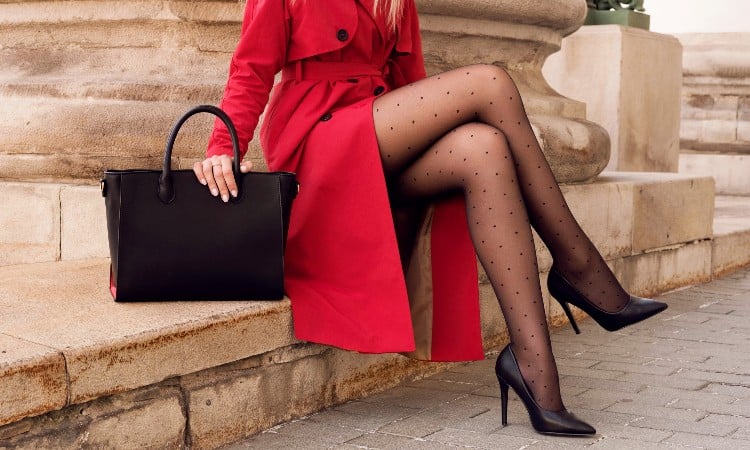
Tights are skin-tight, sheer leg coverings that cover both your feet and legs. They add a fashionable accent to an outfit but should not replace pants because you can see through them! Even thick tights usually stretch so tightly over your body that you can see through the knitted fabric a little bit.
Tights are usually made out of nylon combined with a good amount of elastic fibers such as Spandex or Lycra. They almost always feature a very lightweight knit fabric, made by looping tiny strands of the nylon and elastic together. This creates a very taut, stretchy material perfect for a skin-tight garment.
Typically, tights do not feature visible seams except at the toes and the gusset, a small panel of fabric connecting the legs at the crotch of the garment. They also do not have any fasteners or adornments such as pockets, ruffles, or bows.
Tights and similar kinds of hosiery have been around for literally thousands of years. For instance, in medieval times, both men and women wore clothing that looked a lot like today’s tights. Of course, modern fabric innovations like the invention of elastic made a big difference in the comfort and style of tights today!
You sometimes see tights and stockings grouped as the same thing or categorized as “hosiery.” This makes sense because you wear them for the same reasons–to provide a little warmth or draw attention to your legs! However, you also see stockings/pantyhose/nylons defined as a sub-group of tights since they often feature extremely lightweight, silky, and sheer fabric.
Another somewhat-confusing aspect of the tights vs leggings question is that tights also come in varying thicknesses. You can buy sweater tights that feature colorful knitted cable, fleece-lined tights that provide lots of insulation, or opaque tights with a slightly heavier fabric.
These are still different from leggings because they are intended as an accent or decorative element rather than as pants. Plus, even thicker tights usually don’t provide as much coverage as leggings!
Tights look great with formal clothing such as business suits or dresses. You can also wear them with a stylish, sexy date night outfit. In general, they look best when worn with a dress, skirt, or very long shirt that reaches mid-thigh or to just above the knee.
Though tights have become more mainstream these days, you still mostly wear them for more dressy events. This is because they look best with a skirt or short dress, garments that tend to fall into more formal clothing categories.
Leggings vs Tights: Key Points
This chart will give you a quick overview of the key differences between leggings and tights. For more detail, check out the section below!
| Leggings | Tights | |
|---|---|---|
| Design | Thick, stretchy leg coverings ending at the ankle or mid-calf | Sheer, stretchy leg coverings completely covering the feet. |
| Type of Material | Polyester or cotton knit blended with spandex | Sheer nylon knit blended with elastic fibers |
| Fit | Snug but not too tight | Very tight and entirely form-fitting |
| Length | Common lengths include ankle-length, knee-length, and mid-calf | Usually encase legs and feet |
| Warmth | Depends on type of material | Depends on type of material |
| Weight | Varies a lot, but usually thick enough to wear in place of pants | Usually lightweight, but specialty styles also come in sweater or fleece-lined material |
| Best For | Casual or athletic wear | Business-casual or formal style |
What Is the Difference Between Leggings and Tights?
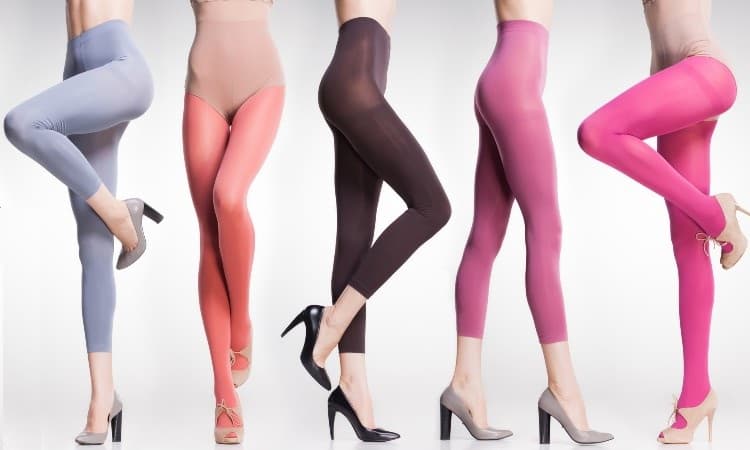
The main difference between leggings and tights is that leggings use opaque material while tights feature sheer material. This means that you can wear leggings on their own in place of pants, but tights cannot be worn in place of pants.
That said, you will find some crossover between what you would usually think of as leggings and what you would usually call tights. After all, the fashion world always likes to push boundaries and find new styles! This means you can find things like sweater tights that look a lot like very fuzzy leggings or footless tights that are quite similar to leggings, except that they use more sheer fabric!
Design
The basic shape of leggings and tights looks similar, as both garments cover your legs and fight very closely to your skin. The main difference in design is that leggings usually end at the ankle, while tights cover the feet entirely. Also, leggings usually feature a visible elastic waist, while tights simply fade up to the waistline without a distinct, separate waistband.
You will also find many design variations among leggings. For example, you have special features like vents or pockets in some athletic styles. Tights pretty much all come in the same basic shape without many bells and whistles.
Type Of Material
Leggings and tights usually feature different types of fabric. Tights use thin, sheer nylon knit, while leggings contain cotton or polyester knit blended with spandex. This makes leggings a bit more durable and means that you can wear them in place of pants if you wish.
Athletic leggings may contain a high percentage of spandex or even be made entirely out of spandex or Lycra. These stretchy, form-fitting leggings have a more plastic-like feel and provide useful benefits for active activities like running or biking.
Fit
Most of the time, tights fit far more snugly than leggings. Leggings contour the shape of your body but don’t provide strong shaping and clinging the way tights do.
Leggings fit very closely to your skin but can come in a variety of cuts and styles, such as low-rise or knee-length. You can also get leggings intended to pad out your behind or with special athletic features such as air vents for better breathability.
Tights almost always have a high rise with an elastic waist ending at your natural waistline. This smooths over your tummy and avoids creating a muffin top situation at your hips. These garments’ very tight, elastic fit offers quite a bit of shaping for anyone who wants a particularly streamlined outline!
Length
In most cases, tights cover you down to your toes. The one exception to this rule is the modern conundrum of the footless tights. These garments fit you like tights but end at your ankles.
Leggings almost always end at your ankle. They are soft, very close-fitting pants. That said, you can also find knee-length or calf-length styles, especially in athletic wear.
Warmth
Are tights warmer than leggings? This depends on the type of material used. Leggings usually provide a thicker, heavier material, but tights with a high denier may provide better insulation because they are less breathable. Plus, you can find tights made out of extra-warm materials like merino wool or real silk!
The denier of a silky fabric describes the weight and thickness of the individual yarns that make up the material. This measurement is, based on the typical thickness of a single strand of silk. A fabric with a higher denier number will feel slightly heavier and will use thicker yarns in its weave or knitted structure.
This means that tights with a lower denier will feel super light and silky, while styles with a higher denier measurement will feel heavier and denser.
Weight
Leggings almost always use thicker, heavier material than tights. This is one of the reasons tights almost always feature translucent, sheer fabric!
Leggings use fabrics like cotton or polyester in sturdy knits made extra stretchy by mixing in elastic fibers like Spandex. Athletic leggings may increase the percentage of spandex quite a lot, creating very elastic fabric.
The heavier-weight material in leggings makes them more durable than tights as well. You can wash them in your washing machine without damaging them, but tights should either get washed by hand or go in a delicates bag in your washing machine.
Best For
Leggings are best for wearing with casual outfits or athletic wear. They pair well with sneakers, t-shirts, and hoodies. For a dressier look, you can wear leggings with a long, chunky sweater, looped scarf, and tall boots!
Tights work best with more formal clothing such as dresses and skirts. Even thick tights usually have a certain level of transparency, meaning that they need clothing layered over top of them and cannot be worn along in place of pants. Tights look great with skirts that end above the knee and with fancier shoes such as heels or flats.
Types of Leggings
Leggings come in many different types and styles, including:
- Stirrup styles feature an elastic loop to hook under the arch of your foot.
- Shaper or compression styles help prevent shin splints and make you look thinner. Special types of shaping leggings include styles that provide specific compression to make your butt look bigger The versions that come with tummy control panels give you a flat midsection.
- Jeggings, or fake jeans, look like denim but still offer the stretchy comfort of leggings. Some jeggings even have fake pockets and zippers!
- Metallic or disco styles feature many shimmery shades of spandex. These work great when you want a dressier outfit!
- Leather or faux leather leggings give you a classy fall style.
- Knee-length versions come in either an athletic style or with cute ruching at the knee.
- Athletic leggings offer many different variations such as air vents, squat proofing, cellulite compression, and more.
Types of Tights
Tights do not have quite as much variation in style, but you can still find multiple different kinds, including:
- Compression versions offer tummy-tuck abilities and support blood flow in your legs.
- Fishnet styles feature larger knitted loops. This style looks good in goth outfits or for a super-sexy outfit.
- Lace styles often contain 100% elastic fibers. You can also find lace tights made out of stretchy nylon.
- Footless tights end at the ankle. The main difference between this kind of garment and leggings is that footless tights feature semi-transparent material.
- Sweater tights usually contain merino wool or cotton instead of nylon and provide extra warmth for cold weather.
- Fleece-lined versions have a soft, fuzzy fleece coating on the inside. These also provide extra warmth for chilly days!
- Sheer versions are your basic semi-transparent tights made from knitted nylon. These often come in black, but you can also find sheers in every color imaginable and plain white or fun printed patterns.
- Opaque versions have a slightly higher denier or thickness than sheer tights. However, even opaque tights fit so closely that you can still see your skin through them just a bit, in most cases!
Leggings vs Tights vs Yoga Pants
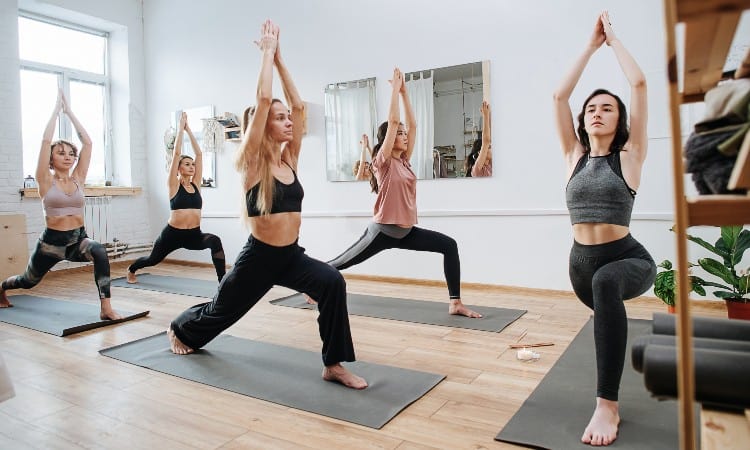
The main difference between leggings, tights, and yoga pants is the type of fabric used in each kind of leg covering.
Tights almost always feature the lightest, most sheer fabric of the three kinds of leg coverings. Leggings come in second, made out of an elastic and light material. Yoga pants typically feature slightly heavier cotton knits and come in different styles that are not skin-tight.
That said, sometimes, the lines between these types of clothing do blur. For example, what is the difference between running tights and leggings?
Running Tights vs Leggings
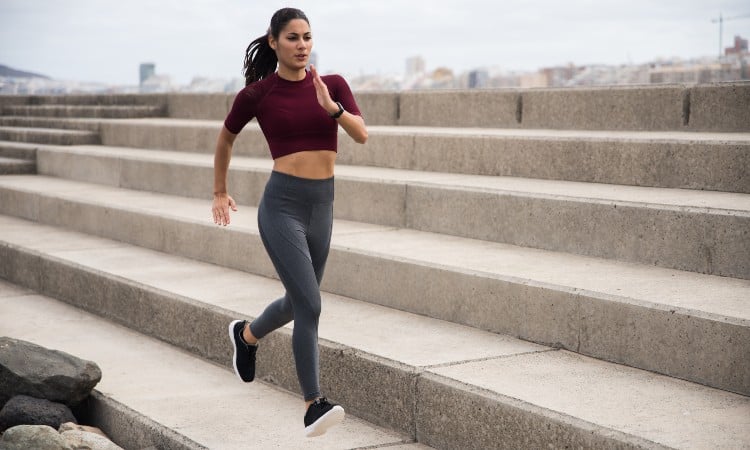
Running tights and athletic leggings look quite similar as they both feature a skin-tight style that ends at the ankle. The main difference between them is that running tights or workout tights use slightly sheer material. You wear this kind of leg covering underneath running or biking shorts as an added insulation in cold weather.
On the other hand, athletic leggings use fully opaque fabric and you can wear them on their own just fine–no need to put shorts over top of them!
Pantyhose vs Leggings
Pantyhose and leggings have many key differences, including the fact that pantyhose are always made out of very fine, sheer fabric, while leggings feature heavier opaque material.
You may also see pantyhose called nylons, sheers, or stockings. Pantyhose generally come in nude, black, or white, and they do not typically feature any prints or patterns. They have a very fine denier and an almost feather-light quality to them.
Leggings have weight and thickness that make them suitable to wear in place of pants.
Leggings vs Stockings
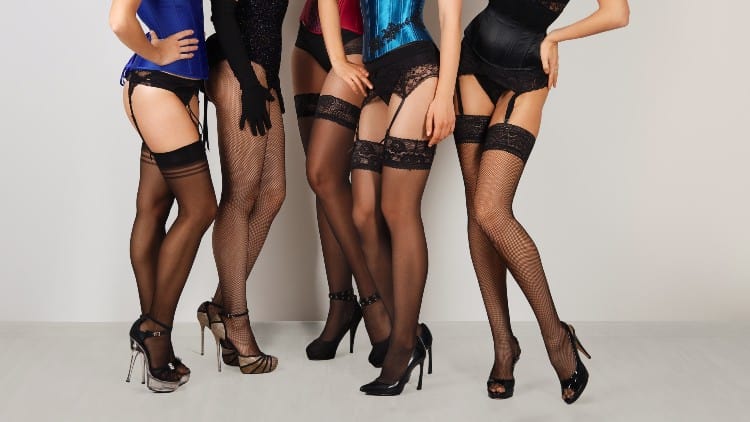
The main difference between leggings and stockings is that leggings can be worn instead of pants, while stockings feature very thin, sheer material meant to be worn beneath a skirt.
Stockings is another name for pantyhose or nylons. This type of sheer leg covering had its heyday from the 1920s through about the 1960s. Women’s lib nearly put stockings out of business as women objected to mandatory stockings in the workplace and other formal settings.
Today, you do not see stockings worn among younger generations, but they remain popular among older women. Plus, even younger women often wear the more old-fashioned stocking style for events such as weddings or funerals.
Is It Ok to Wear Tights as Pants?
Since tights often feature see-through material, you should not wear them in place of pants. If you feel comfortable with it, leggings are often worn in place of pants, though!
The main difference here is that you want opaque fabric covering at least your seat and upper thighs. For this reason, you can get away with leggings, but not tights, in place of pants.
On the other hand, you need to feel very comfortable with the shape of your body to wear leggings as pants. You may feel more comfortable pairing your leggings with a loose, long sweatshirt that covers your seat comfortably.
Can you wear leggings instead of tights? In many cases, you can easily substitute leggings for tights, but keep in mind that sheer tights have a more formal style than knit leggings. If you want a casual appearance, you can easily substitute leggings for tights–both garments will keep your legs warm!
If you do not like the idea of making the shape of your legs super-visible, you may want to try looser yoga pants instead. You can also wear longer skirts like maxi skirts to avoid the necessity of wearing tights.
How to Wear Tights and Leggings

Now that you know exactly what tights and leggings are check out some tips for wearing these close-fitting, stylish types of clothing!
For tights:
- Sheer tights look classy and even a little sexy when paired with an above-the-knee skirt or dress.
- If you live in a very cold place, you may want to try trendy variations on tights, such as sweater tights or fleece-lined tights. These will feature opaque fabric, so you can safely pair them with a long, loose top if you want! Just don’t match sweater tights with an actual sweater unless you really, really like to embrace yarn style.
- Since tights often have a bit of a formal appearance, they usually look best with heels or fancy flats. Sometimes, you can pair them with ankle boots for a more casual fall or winter style. You do not want to wear open-toed sandals, boots, or heels with tights or stockings, though!
- Another fun trend in tights is sheer patterned tights. These can get as funky as fishnet stockings or as cutesy as printed kittens! The key to pulling off patterned tights is to pair them with a solid-colored outfit, such as a black skirt and red sweater. You can also look very stylish in a nice wool coat and patterned tights!
For leggings:
- Leggings usually feature thicker fabric which means you can wear them instead of pants. That said, you may still want to pair them with a shirt or top that hangs down low enough to cover your seat.
- When you pick a top to pair with leggings, think about your overall silhouette. Leggings will make your lower half look quite narrow, so you may want a more voluminous top, like a loose sweater or a flounced shirt.
- Generally speaking, leggings go well with casual outfits that you would wear to the gym, out jogging, or while you run errands. They pair well with casual footwear like sneakers or plain flats.
- If you like the “pumpkin spice latte” style of fall clothing, try pairing fancier or faux-leather leggings with a chunky sweater and cute flats!
Conclusion
Leggings and tights are both close-fitting styles of leg coverings, but they have many key differences, including the kind of material used in each. Tights usually contain a sheer fabric made from fine knitted nylon combined with elastic, while leggings use a thicker, more durable fabric made of knitted cotton or polyester and elastic. Leggings come in varying lengths, while tights almost always cover the whole leg and the feet.
Tights and leggings also have key style differences. Leggings are usually worn for casual occasions or athletic activities. Tights accessorize more dressy or formal outfits and are worn under a skirt or dress.
What is your favorite kind of tights? What do you like to wear with your leggings? Leave a comment below to let us know!